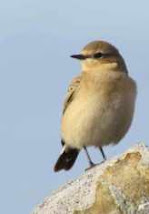It rained in the morning and threatened to be wet for the
afternoon, but the skies began to brighten at lunchtime and the MET office
radar images said the last of the rain had passed. All set then for another Sunday
rAmble, so despite the weather prospects and the competition with a certain
tennis match that afternoon, I went forth in anticipation - would anyone be
interested in the walk? Happy to say 3
folk were keen and so glad they were as it turned into a lovely warm afternoon,
the sun appeared, the ground was moist and warm, and the butterflies were already
on the wing and visiting the flowers.
Whilst waiting at the bridge my eye was caught by a bush/small tree on either
side of the bridge tree with newly developing berries. I could not place the
species (I do pride myself on knowing most of our native trees very well) so it
was a puzzle. On my return I checked
through a number of tree guides and eventually found it to be a Himalayan
Tree-cotoneaster (Cotoneaster bullatus),
an introduced, naturalised species, and not recorded on our database!
 |
| Cotoneaster bullatus |
 |
| Sessile Oak |
The walk to Dun Nosebridge takes a route through woodland
with a nice mix of tree species, hazel, birch, sloe (blackthorn) and some
lovely mature Sessile Oak. We chanced
upon a small family party of Long-tailed tits, always a joy to see. There were Speckled Wood butterfly, Meadow
Brown, Green-veined White, Small Heath and one chance sighting of a still (but
only for a split second) Dark Green Fritillary.
A few dragonflies quartered about with a Golden Ringed slow enough to
identify. There were many Six Spot
Burnet moths, obviously the time of the season for them. Plodding slowly but purposefully across the
track were the occasional Dor Beetle heading in search of dung.
 |
| 6-spot burnet moth |
The ramparts of the old iron age fort held the most variety
of flowering plants: Thyme (including some white flowering clusters),
Birds-foot Trefoil, English Stonecrop, Sorrel, Tormentil, Lady's Bedstraw, Self
Heal and a good look was had at the three main thistle species, Creeping, Marsh
and Spear. Amongst the spikes of the
thistle heads were soldier beetles and harvestman spiders. Great views from the ramparts down to the
River Laggan below and nearby: Neriby Hill had Buzzard, Hen Harrier and Raven
all flying over.
 |
| Beetle and harvestman - can you spot both? |
The last puzzle species yet to be identified was a very
large hoverfly feeding on the creeping thistle, a good look through the Trust
library is needed.
A very pleasant afternoon walk in good company, and still
back in time to watch the end of the tennis :-)
Fiona McG














No comments:
Post a Comment